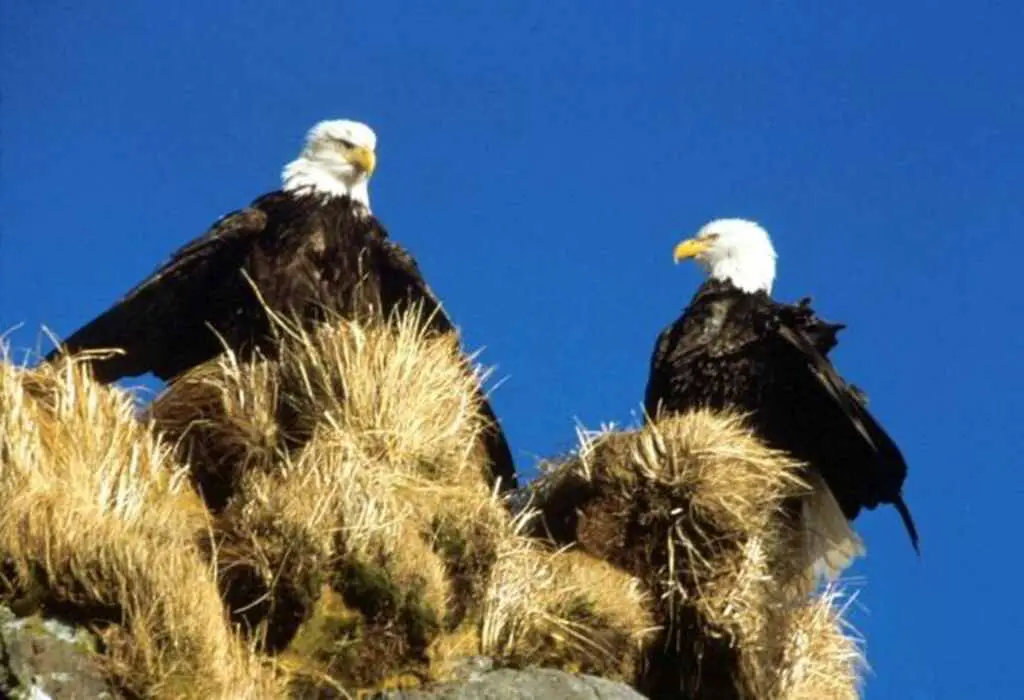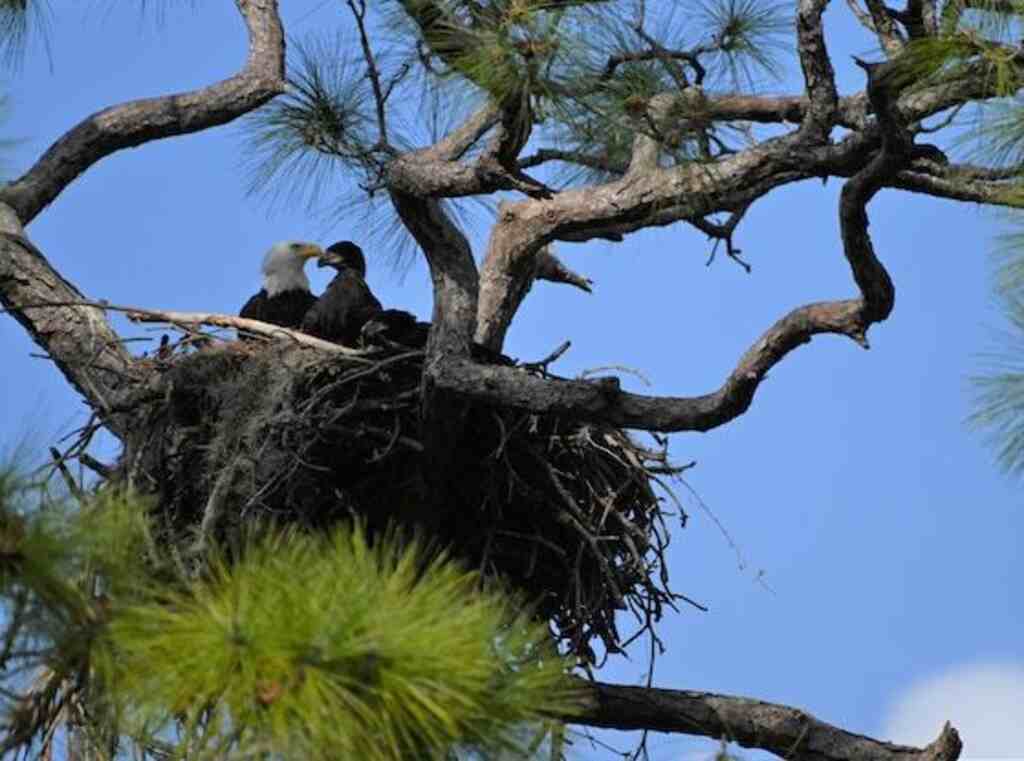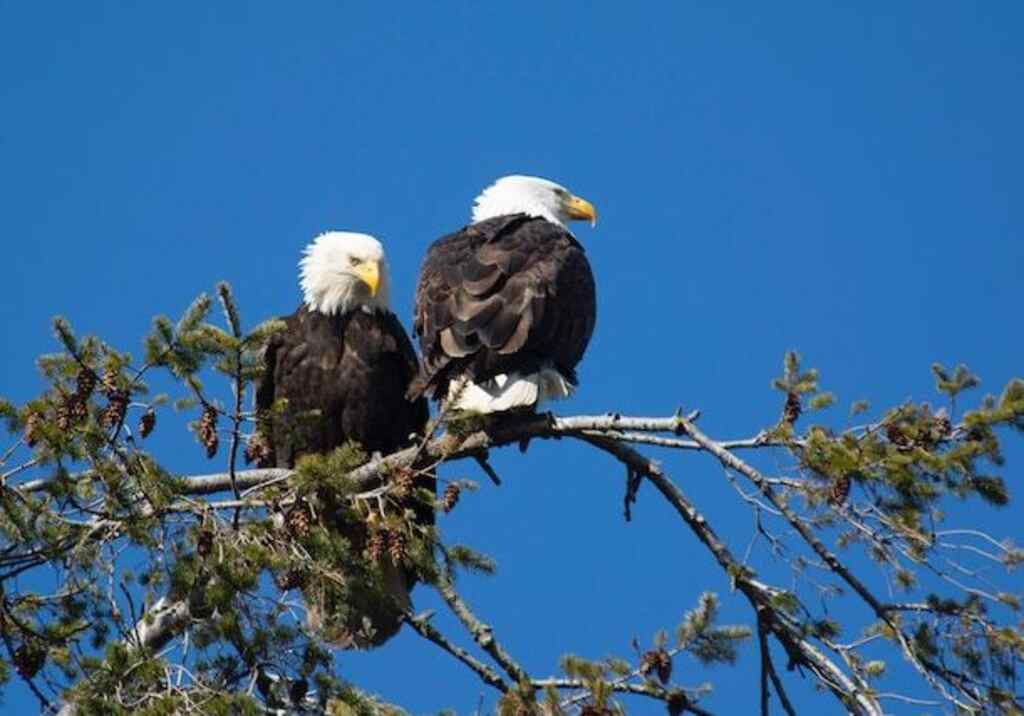At What Age Do Bald Eagles Mate? This question captivates researchers and nature enthusiasts alike, as understanding their sexual maturity is crucial for comprehending their reproductive patterns.
This article delves into scientific literature to shed light on factors influencing bald eagle mating age, courtship rituals, bonding, and nesting.
We’ll discuss challenges and conservation efforts, examining reproductive success and parental care to gain insight into their mating behavior.
This knowledge may guide future research and conservation strategies to ensure the continued freedom and prosperity of these iconic creatures.
Table of Contents
- 1 Key Takeaways
- 2 At What Age Do Bald Eagles Mate
- 3 Bald Eagle Sexual Maturity
- 4 Factors Influencing Bald Eagle Mating Age
- 5 Bald Eagle Courtship Rituals
- 6 Importance of Bonding Before Mating
- 7 The Role of Nesting in Bald Eagle Mating
- 8 Bald Eagle Monogamy and Lifelong Partnerships
- 9 Reproductive Success and Parental Care
- 10 Challenges and Threats to Bald Eagle Mating
- 11 Conservation Efforts for Bald Eagles
- 12 Conclusion and Future Research on Bald Eagle Mating Behavior
- 13 Frequently Asked Questions
- 13.1 How long do bald eagles stay with their lifelong partners?
- 13.2 What are the main threats to bald eagle mating?
- 13.3 Are there any conservation efforts in place to protect bald eagle mating habits?
- 13.4 Is nesting behavior crucial for bald eagle mating success?
- 13.5 What are the courtship rituals of bald eagles like?
- 14 Author
Key Takeaways
- Bald eagles achieve sexual maturity at 4-5 years of age.
- Factors influencing bald eagle mating age include food availability, habitat quality, and competition for mates.
- Bonding before mating is important for establishing a strong bond between potential mates.
- Bald eagles form monogamous lifelong partnerships and reinforce these partnerships through mating rituals and returning to the same nesting site each year.
At What Age Do Bald Eagles Mate
Bald eagles typically reach sexual maturity at around 4–5 years of age. At this stage, they begin to form pairs and engage in courtship behaviors, leading to mating. However, some eagles might mate later, depending on various factors such as food availability and territorial status.
Bald Eagle Sexual Maturity
Bald eagles achieve sexual maturity at a specific age, marking the onset of their reproductive capabilities. This milestone is crucial for their breeding behavior and nesting habits.
Sexual maturity in bald eagles typically occurs around the age of four to five years. At this point, both male and female eagles are physically and behaviorally ready to engage in mating activities.
Bald eagles are known for their elaborate courtship displays, which involve aerial acrobatics and vocalizations. Once a pair forms a bond through these displays, they proceed to build a nest together.
Bald eagles typically construct their nests in tall trees near bodies of water, providing a secure environment for their offspring.
Factors influencing bald eagle mating age include food availability, habitat quality, and competition for mates.
These elements will be further explored in the subsequent section on factors influencing bald eagle mating age.
Factors Influencing Bald Eagle Mating Age
One of the key determinants of the timing of bald eagle pair formation and reproduction is influenced by various factors. These factors can include environmental conditions, availability of suitable nesting sites, and the availability of prey.
The age at which bald eagles reach sexual maturity is also a factor that influences the timing of mating.
Bald eagles typically reach sexual maturity at around four to five years of age, but this can vary depending on individual factors such as diet and overall health.
Additionally, competition for mates and territorial disputes can also influence the age at which bald eagles choose to mate.
Understanding these factors can provide valuable insights into the reproductive behaviors of bald eagles.
Transitioning into the subsequent section about bald eagle courtship rituals, it is important to note that these rituals are intricately connected to the timing of mating.
Bald Eagle Courtship Rituals
Courtship rituals in bald eagles are a delicate dance, with potential mates engaging in an intricate aerial ballet, their wings intertwined like branches reaching towards the sky.
These rituals play a crucial role in establishing a bond between male and female eagles before they engage in mating.
Bald eagle courtship behavior involves a series of displays, such as soaring together, calling to each other, and performing acrobatic maneuvers in mid-air.
These displays not only showcase the eagles’ physical capabilities but also serve as a means of communication and attraction.
The male and female eagles engage in synchronized flights, where they lock talons and spiral downwards before releasing. These displays demonstrate the eagles’ compatibility and strengthen their bond.
Through these courtship rituals, bald eagles ensure that they are selecting a suitable partner for successful reproduction.
This bonding process is essential for their long-term reproductive success, and ultimately leads to the subsequent section on the importance of bonding before mating.

Importance of Bonding Before Mating
Establishing a strong bond between potential mates is critical for bald eagles to ensure successful reproduction and long-term reproductive success.
To accomplish this, bald eagles employ various bonding techniques and communication strategies.
One common technique is the mutual aerial display, where the male and female eagles engage in an intricate flight pattern, often accompanied by vocalizations.
This display not only showcases their physical prowess but also serves as a means of communication between the pair.
Another bonding technique is the exchange of food, with the male offering prey to the female as a gesture of courtship.
This behavior not only helps to establish trust but also demonstrates the male’s hunting abilities and willingness to provide for the female and potential offspring.
These bonding techniques and communication strategies lay the foundation for a successful mating season and ensure a strong bond between the bald eagle pair.
Transitioning into the subsequent section, the role of nesting plays a crucial role in bald eagle mating.
The Role of Nesting in Bald Eagle Mating
Nesting behavior plays a vital role in the reproductive success of bald eagles. The construction and maintenance of nests are key aspects of bald eagle mating behavior.
Nests provide a secure and stable environment for the eggs and young eaglets, ensuring their survival.
Bald eagles typically build their nests in tall trees near bodies of water, where they have easy access to food sources.
These nests are large and sturdy, often measuring up to 10 feet in diameter and weighing several hundred pounds.
The table below provides a glimpse into the nesting habits of bald eagles, showcasing their preference for specific nesting sites and materials.
Understanding the role of nesting in bald eagle mating behavior is crucial for conservation efforts aimed at protecting their habitat and ensuring their continued reproductive success.
| Nesting Habit | Examples |
|---|---|
| Nest Location | Trees near water bodies |
| Nest Size | Up to 10 feet in diameter |
| Nest Weight | Several hundred pounds |
This emphasis on nesting demonstrates the importance of understanding the role of nesting behavior in the mating habits of bald eagles.
It sets the stage for the subsequent section, which explores the fascinating topic of bald eagle monogamy and lifelong partnerships.
Bald Eagle Monogamy and Lifelong Partnerships
Lifelong partnerships are a defining characteristic of bald eagle behavior, as these majestic birds form monogamous bonds that endure throughout their lives.
Bald eagle breeding habits revolve around these partnerships, with individuals typically mating for life.
This commitment is demonstrated through elaborate mating rituals, where the male and female engage in a series of aerial displays, vocalizations, and courtship flights.
These rituals serve to strengthen the pair bond and ensure reproductive success.
Bald eagles often return to the same nesting site year after year, reinforcing their lifelong partnership and further solidifying their bond.
This monogamy contributes to their reproductive success and ensures the provision of parental care, as both parents share in the responsibilities of incubating the eggs, protecting the nest, and raising the young.
With this understanding of bald eagle mating rituals, we can now explore their reproductive success and parental care.

Reproductive Success and Parental Care
Reproductive success and parental care are crucial aspects of bald eagle behavior, highlighting the commitment and dedication these birds have towards ensuring the survival of their offspring.
Bald eagles typically mate for life, forming monogamous pairs that work together to raise their young.
They engage in elaborate courtship displays, which involve aerial acrobatics and vocalizations, strengthening their pair bond.
Once the female lays her eggs, both parents take turns incubating them for approximately 35 days.
After hatching, the eaglets are cared for by both parents, who provide food and protection until they fledge at around 10–12 weeks of age.
Parental care continues even after the juveniles leave the nest, as the parents teach them essential hunting and survival skills.
This level of parental investment contributes to the reproductive success of bald eagles, ensuring the survival of their species.
Moving forward, it is important to understand the challenges and threats to bald eagle mating in order to develop effective conservation strategies.
Challenges and Threats to Bald Eagle Mating
This paragraph discusses the challenges and threats to bald eagle mating, specifically focusing on habitat loss, pollution and contamination, and human disturbance.
Habitat loss is a major concern for the bald eagle population, as deforestation and urban development can destroy their nesting sites and foraging grounds.
Additionally, pollution and contamination, such as pesticides and heavy metals, can affect the reproductive success of bald eagles by impairing their health and the quality of their eggs.
Lastly, human disturbance, such as recreational activities and habitat encroachment, can disrupt the breeding behavior of bald eagles and lead to nest abandonment.
Habitat Loss
In the face of increasing habitat loss, bald eagles find themselves navigating a shrinking landscape like a solitary ship in a vast ocean.
Habitat destruction, primarily caused by human activities such as deforestation and urbanization, has resulted in a significant decline in the bald eagle population.
This loss of suitable habitat has forced bald eagles to compete for limited resources and nesting sites, leading to increased stress and reduced breeding success.
To emphasize the gravity of habitat loss, consider the following:
- Destruction of nesting trees: As forests are cleared for agriculture or development, the availability of suitable nesting trees diminishes, leaving bald eagles without secure breeding sites.
- Fragmentation of habitat: The fragmentation of once continuous habitats isolates eagle populations, limiting genetic diversity and increasing the risk of inbreeding.
- Disruption of food sources: Habitat loss can disrupt the balance of ecosystems, leading to a decline in prey species that bald eagles rely on for sustenance.
- Increased human-wildlife conflicts: As bald eagles are forced to search for new habitats, they come into closer contact with human activities, increasing the likelihood of negative interactions.
In the face of such challenges, bald eagles now also face the additional threat of pollution and contamination.
Pollution and Contamination
Pollution and contamination pose a persistent threat to the survival of bald eagle populations, as toxic substances infiltrate their habitats and permeate the delicate balance of their ecosystems.
The effects of pollution on bald eagles can be devastating. These majestic birds are at the top of the food chain and are particularly susceptible to accumulating toxins from their prey.
The primary sources of contamination include pesticides, heavy metals, and industrial pollutants.
These substances can accumulate in the eagles’ bodies, leading to reproductive issues, weakened immune systems, and impaired growth and development.
The impact of pollution on bald eagle populations is evident in reduced breeding success and increased mortality rates.
| Pollution Effects | Contamination Sources |
|---|---|
| Reproductive issues | Pesticides |
| Weakened immune system | Heavy metals |
| Impaired growth | Industrial pollutants |
| Increased mortality |
The pollution and contamination faced by bald eagles are just one aspect of the challenges they encounter. Human disturbance and habitat degradation further threaten their survival.
Human Disturbance
Human disturbance poses a significant threat to the survival of bald eagle populations, eliciting concern for the future of these majestic birds.
Human interference can disrupt the mating behavior of bald eagles, leading to reduced reproductive success.
This disruption can occur in various ways, including habitat destruction, noise pollution, and disturbance during nesting.
The presence of humans near nesting sites can cause eagles to abandon their nests or eggs, resulting in a decreased population growth.
Furthermore, human activities such as boating, fishing, and recreational activities in eagle habitats can lead to direct disturbances and collisions, causing injury or death to these birds.
Conservation efforts for bald eagles aim to mitigate the negative impacts of human disturbance through habitat protection, education, and the enforcement of regulations.
To continue addressing the challenges faced by bald eagles, it is crucial to explore conservation efforts for these birds.

Conservation Efforts for Bald Eagles
Conservation measures for Bald Eagles focus on promoting population growth and protecting their habitats.
To ensure bald eagle population growth, conservation efforts aim to minimize disturbances during the breeding season, as these disturbances can disrupt the eagles’ reproductive behaviors.
By limiting human activities in nesting areas and enforcing protective regulations, conservationists help reduce breeding season fluctuations and encourage successful mating and nesting.
Efforts are also made to preserve and restore suitable habitat for bald eagles, including protecting nesting trees, maintaining water quality in their foraging areas, and mitigating threats from pollution and habitat loss.
These conservation initiatives are crucial for maintaining and expanding bald eagle populations.
In conclusion, future research on bald eagle mating behavior can provide valuable insights into their reproductive biology and inform further conservation efforts.
Conclusion and Future Research on Bald Eagle Mating Behavior
A deeper understanding of the mating behavior of Bald Eagles can provide valuable insights into their reproductive biology, contributing to the development of more effective strategies for their conservation and population management.
Bald eagles typically reach sexual maturity and begin to mate around the age of four to five years. However, successful breeding may not occur until they establish a territory and find a suitable mate.
Citizen science initiatives have played a significant role in collecting data on bald eagle mating behavior, helping researchers gain a more comprehensive understanding of their reproductive habits.
Climate change can also impact bald eagle mating behavior, as shifts in temperature and precipitation patterns can affect the availability of prey and nesting sites.
Thus, future research should focus on evaluating the long-term effects of climate change on bald eagle populations and their breeding success, in order to develop effective conservation strategies.

Frequently Asked Questions
How long do bald eagles stay with their lifelong partners?
Bald eagle pair bonding and mating rituals are characterized by a lifelong commitment. Once they establish a territory, they actively engage in courtship behaviors and mate. The duration of their partnership can last for many years, ensuring reproductive success and species survival.
What are the main threats to bald eagle mating?
Bald eagle mating is threatened by habitat loss, pollution, and disturbance. They typically mate at around 4-5 years old. Attention to these threats and preservation of their habitats are crucial to ensure their successful reproduction and population growth.
Are there any conservation efforts in place to protect bald eagle mating habits?
Conservation strategies and breeding programs are in place to protect bald eagle mating habits. These efforts aim to address the main threats to their mating, ensuring the long-term survival and reproductive success of the species.
Is nesting behavior crucial for bald eagle mating success?
Nesting behavior is crucial for bald eagle mating success. Research shows that eagles with established nests have a higher chance of successful mating, as the nest provides a stable environment for raising offspring.
What are the courtship rituals of bald eagles like?
Bald eagles engage in elaborate courtship displays as part of their mating behavior. These displays involve aerial acrobatics, vocalizations, and gift-sharing rituals, which are crucial for pair bonding and mate selection.




